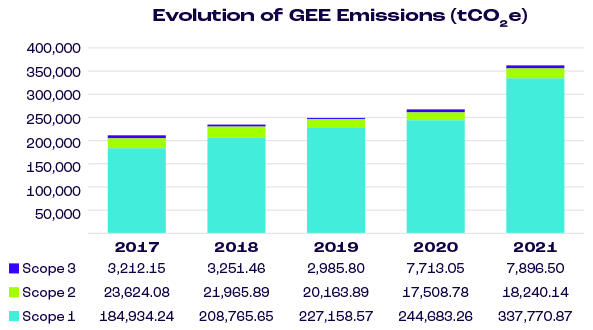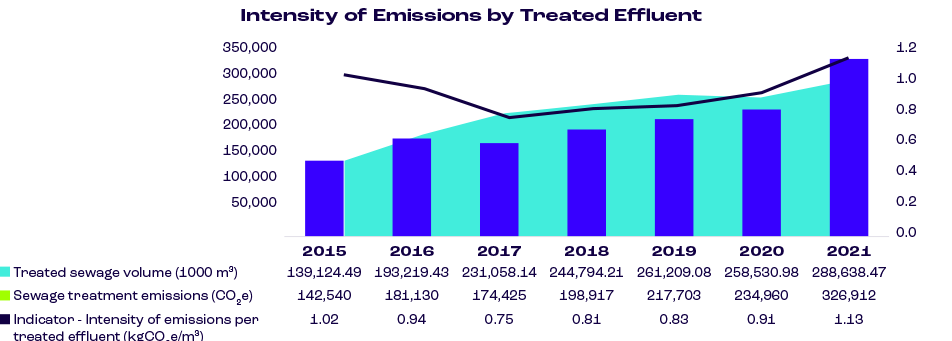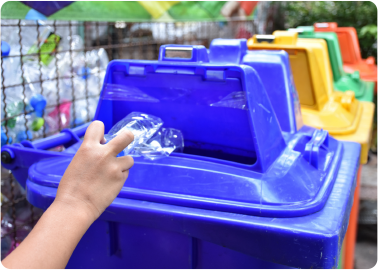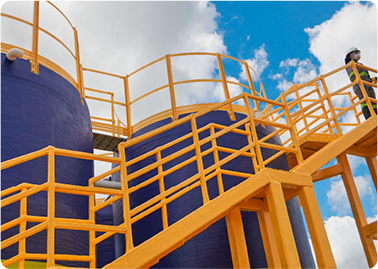Reducing CO2 emissions is a BRK commitment
The company assumes Net-Zero commitment by 2040
The “less is more” principle, used in so many everyday situations, perfectly illustrates BRK’s commitment when it comes to GHG emissions resulting from the company’s
operations. The less carbon emitted into the atmosphere in water and sewage activities, the more the company will contribute to improving people’s quality of life and
generating business opportunities.
That’s why BRK has adopted a long-term, data-driven strategy to understand how to be more efficient and reduce its carbon footprint. In 2020, it created an internal model
for CO2 pricing, with the objective of mapping opportunities and prioritizing projects to reduce GHG emissions with the greatest potential for return. Thus, the projects that
reduce more emissions and generate more benefits are placed ahead of the others, optimizing the allocation of financial resources.
BRK is committed to achieving net greenhouse gas (GHG) emissions by 2040. In order to guarantee the journey to Net Zero, intermediate control targets of 10% reduction
by 2025 and 30% by 2030 were established. To achieve these goals, a portfolio of mitigation projects that are divided into four main groups was created: 1) Efficient sewage
treatment plants, with potential to reduce 90% of emissions; 2) Solar sludge dryers; 3) Biogas burners; 4) Self-generation of electricity from renewable sources.

Projects to reduce emissions
BRK incorporates new technologies for sewage treatment and, in this way, adds environmental benefits related
to GHG emissions. The Nereda® system, for example, is used in BRK ETEs to promote the treatment of sewage
at a tertiary level: removal of nutrients (nitrogen and phosphorus) for the same investment amount made in a
secondary treatment system, made with simple removal of organic load. This technology allows for a reduction of
up to 90% of GHG emissions compared to traditional sewage treatment processes.
The innovative oxygen infusion system, responsible for aerating the effluents without the need for blowers to
produce bubbles, also guarantees a reduction in energy consumption in the tank aeration process.
• The Nereda® system for tertiary treatment requires less investment, has automated handling, and brings a lower
operating cost of approximately 30% to traditional processes.
• A Nereda® plant requires an average area 40% smaller than conventional models.
• BRK has the goal of reaching seven ETEs in operation with the Nereda® system by 2025.
In energy efficiency, still in 2019, we established a target of energy consumption from renewable sources of
50% by 2021. Thanks to the implementation of photovoltaic energy self-generation plants and the purchase of
renewable energy in the Free Market, we overcame this challenge, reaching 54% of electricity consumption in
2021. We have set a new target of 70% electricity consumption from renewable sources by 2030. In our energy
strategy, the ESG Agenda is a journey that motivates and challenges us in our daily lives.

Emissions management
BRK prepares and publishes its GHG emissions inventory annually. The document follows the guidelines of the
Brazilian GHG Protocol Program, recognized as the best practice for this type of measurement. Emissions are
accounted for in three different scope types:
• Scope 1: direct emissions from operations
• Scope 2: indirect emissions from purchased electricity
• Scope 3: other indirect emissions in the company’s value chain
The information and data for the preparation of the inventory are collected by the business units and consolidated
using specific software. Then, the company validates the numbers and calculates its total emissions.
In addition to the total volume of GHG, the intensity of emissions is an important indicator for the company’s
progress in managing the issue. BRK accounts for emissions in relation to the volume of treated sewage (tCO2/1.000m³)
annually, to assess the efficiency of the processes and technologies adopted.

Between 2018 and 2020, the behavior of greenhouse gas emissions remained constant with annual increases of around 5%, pulled by scope 1. In 2021 the increase in
emissions is due to a set of factors, among them stands out the inclusion of the calculation of nitrogen emissions in the effluent treatment stages, which alone corresponds
to 15% of the 2021 emissions. Added to this is, the increase in methane emission factor and the incorporation of the Metropolitan Region of Maceió, BRK'S new operation,
adds the management of 13 more municipalities to our inventory.
This increase is reflected in the increase in the emission indicator, which in 2021 stood at 1.13 kCO2e/m3. However, when observing the behavior of the intensity indicator
without the inclusion of nitrogen emissions associated with effluent, that is, maintaining the variables equal to previous years, we obtained 0.94 kgCOe/m3, within the trend
range observed in previous years.

This increase in scope 1 emissions, in addition to improving the management and reporting of data, is within the normal range of our business, because in addition to
the organic growth of the company, BRK is always in search of growth and new areas of activity implying in a greater scope of the business. It is worth noting that, as the
implementation of the main mitigation projects approved in the portfolio, the reduction of GHG emissions will have an effect in the 2022 inventory, according to low carbon
scenarios estimated by BRK, towards the Net-Zero goal. In relation to scope 2, the increase in electricity consumption through renewable sources has been producing
positive effects on GHG emissions annually.

What about the other atmospheric emissions?
BRK maintains control and measures to minimize its emissions atmospheric, having as basic premise of the
application of its procedures the stage of identification of potential polluting sources. Thus, considering its
operations, in addition to greenhouse gases, BRK maps and controls other emission sources, the main ones
being: Particulate Matter (PM) and Black Smoke. These air pollutants are mainly associated with fuel combustion,
chemical processes and "resuspension" in the atmosphere. Thus, they are of important measurement in the
industrial and transformation sector. For sanitation, the main source of these pollutants is associated with the
works and operations of management of their assets, not material in the face of emissions from the consumption
of organic compounds in the sewage treatment stages.
Still, BRK maintains non-greenhouse gas emission management programs. To control these emissions, it has
mitigation measures, management and monitoring such as the sprinkling water on roads with land movement
and definition of limits of speeds, fleet control being provided preventive maintenance of vehicles and equipment,
monitoring of black smoke, among others.














